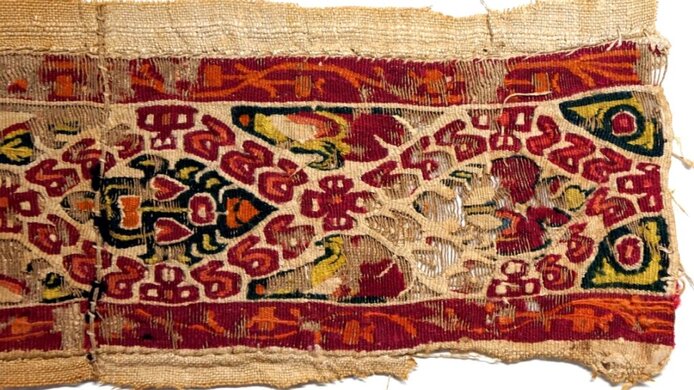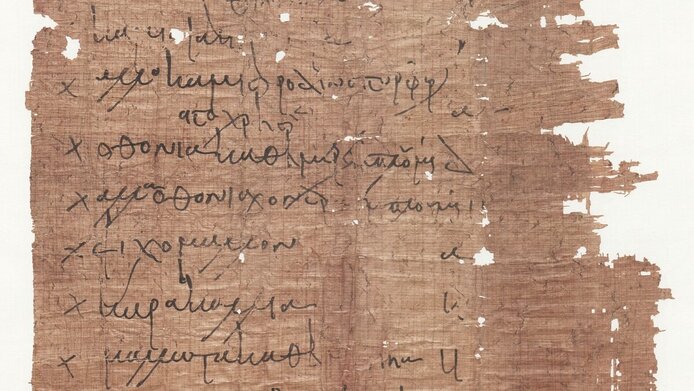How does that fit together?

Many people know the term “patchwork”, referring to an old textile technique, (usually) involving square pieces of leftover fabric sewn together. Hearing the term immediately evokes a mental image. If scientists in the distant future were to stumble upon the term in old texts, however, it is doubtful whether they would see a connection between patchwork and cast-off textile fragments. “The text alone would probably not provide them with a clear idea. Moreover, they would wonder: why did they use this English word in a German text? What is it supposed to mean?”, explains Bernhard Palme, Professor of Ancient History and Papyrology at the University of Vienna. This example seen from today illustrates the challenges the papyrologist encountered at the outset of his current research project.
Going separate ways
This FWF-funded project focuses on textile production in Egypt in the Late Antique period (ca. 300 to 800 AD). Up until now, the artefacts as such and their content have always been investigated separately. Papyrology was devoted to the terminology used in papyrological sources, whilst historical textile research dealt with ancient textile fragments. The meaning of numerous terms remained abstract and unclear. Conversely, textile research missed out on important information about textile fragments which are often only the size of the palm of a hand. In order to better understand textile processing of that period, the principal investigator, Bernhard Palme, has now built a bridge between the two disciplines in his research project Texts and Textiles in Late Antique Egypt. Palme and his interdisciplinary team postulated that joint analysis would achieve a better understanding of terminology, textiles, production methods, materials and usage.
Lost diversity
Papyrology also confronted another challenge: the wealth, range and differentiation of terms which still existed in ancient Greek sources has been lost. “In the 19th century, the time when most language dictionaries were written, the philologists of the time did not engage in a particularly intense study of the material culture”, notes Palme. One of the most important reference works for ancient Greek still contained six terms for textile workers, but the translations called all of them “weavers”. This phenomenon not only affects job designations, but also dyes, production methods and different uses. In antiquity, textile production was a central sector of the economy, which is why the terms appear in very many originals. The ‘Price Edict’ issued by the Roman Emperor Diocletian from the year 301 AD is a case in point: around one third of the products mentioned came from the textile sector.
The search for results
In 2015, Palme started his cooperation with Ines Bogensperger, an expert in historical textile research, and the Greek papyrologist Aikaterini Koroli, who both hold positions at the Austrian Academy of Science’s Institute for the Study of Ancient Culture. They screened a great number of texts from papyrological originals published in globally accessible online databases for known technical terms. Many antique textiles are also digitally accessible. In the research project, the scientists concentrated on the textile collections of the Vienna Museum für Angewandte Kunst (MAK), the Papyrus Collection of the Austrian National Library, the Abegg-Stiftung in Riggisberg (Switzerland) and the staatlichen Museen zu Berlin. Their tenet was: the richer the context, the clearer the meaning. By studying many items word by word, the experts also made new discoveries. “The term ‘stencilled’ came up a lot. Given that many textiles were decorated on a loom or by embroidery at that period, we didn’t know what ‘stencil’ meant in that context”, recalls Palme. The textile expert discovered a few objects that fit the description, but it took the interdisciplinary collaboration to find out that there was, indeed, a stencil technique in Byzantine Egypt which was used to create textile patterns not only by weaving or embroidery, but also by dyeing. The researchers also investigated ancient literature: “By looking at all the references and reading texts from different contexts we hoped to obtain enough information even on problematic terms”, says the papyrologist. In about 70 percent of cases, the matching of term and item resulted in a precise definition of the term.
Integrated practical knowledge
The ancient textile fragments also held some mysteries. Scientific methods such as microscopy can be used to analyse many material details, but how did different techniques work? This challenge gave the scientists the idea for another project, Antique Textiles – Modern Hands, aimed at tapping the huge technical knowledge and expertise of modern-day amateur producers of textiles. Also funded by the FWF in the context of the Top Citizen Science (TCS) initiative, this second project will run until August 2019. Selected antique textiles and patterns were made available to a global community via an internet forum (spiraltextile.com): How is it made? How much work does it involve? What do you need to do it? The practitioners recreated the items and thus provided an insight into how they are made and how valuable they are. Dozens of these new samples are going to be presented in a travelling exhibition. The comprehensive gain in knowledge about terminology and related objects is to be showcased in a visual encyclopaedia. Unlike the encyclopaedias of the 19th century, it will preserve the diversity of terms and present every term together with the appropriate object – thereby creating new mental images.
Personal details The Director of the Department of Papyri and Papyrus Museum of the Austrian National Library since 2009, Bernhard Palme holds a chair in Ancient History and Papyrology at the University of Vienna. An internationally sought-after expert, he has held numerous relevant scientific positions. In 2012 he was appointed a member of the Austrian Academy of Sciences.
Top Citizen Science (TCS) Spiral Textile 2.0 is a platform to crowdsource textile production experiments for research. The project was inspired by an ancient spiral design drawn on papyrus dating from the late Roman periof in ancient Egypt. Fiber artists from around the world participate in this project. Top Citizien Science funding initiative
Publications






